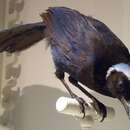en
names in breadcrumbs


Perception Channels: visual ; tactile ; acoustic ; chemical
Cyanolyca cucullata may be a rare bird like other Cyanolyca species, but it has not been well-studied. The first record of nesting was not published until 1984. Deforestation and other common threats could have an affect on the population of this bird (Winnett-Murray et al. 1988).
US Federal List: no special status
CITES: no special status
IUCN Red List of Threatened Species: least concern
No specific negative effects are known, but some tropical jays are pests that destroy and eat crops such as pineapples, orchards, cane, vegetables, and potato plantings (Sick 1993).
Seed caching behavior probably results in the spreading of seeds, increasing the distribution and diversity of plant species. (Sick 1993).
Cyanolyca cucullata is omnivorous, eating seeds, berries, small dead animals, and occasionally steals bait from snares set for small mammals. Cyanolyca cucullata mostly forages in the canopy high above the forest floor(Goodwin 1986).
Cyanolyca cucullata inhabits southeastern Mexico, mainly on the Caribbean slope (Blake 1953). South through east-central Oaxaca and interior Chiapas to Guatemala; Western Panama and Costa Rica. Cyanolyca cucullata is also found in ranges of the tropical forests, in foothills, and in lowlands, but only when these have continuous cloud forest (Goodwin 1986).
Biogeographic Regions: nearctic (Native ); neotropical (Native )
Found in humid, tropical forests, including mountains.
Terrestrial Biomes: forest ; rainforest ; mountains
Cyanolyca cucullata is similar in size to the Blue Jay, but has a larger body structure to support the amount of flying it must do. The feathers at the crown and nape are light, bright blue. The rest of the head, neck, upper mantle, and upper breast are black, and further down the body the feathers turn into a dark, purplish blue. There is a distinct white band that separates the bright blue head and the dark tones of the rest of the body. This band is a diagnostic feature of Cyanolyca cucullata. Young Cyanolyca cucullata have the same markings as adults, but the coloring is a lot duller, and the feathers are not nearly as shiny. The bright blue coloring makes the bird easy to spot and can make it more susceptible to predators (Goodwin 1986).
Average mass: 1000 g.
Other Physical Features: endothermic ; bilateral symmetry
Mates usually preen each other (one bends down in front of the other and pulls down at the throat feathers). There tends to be a constant movement of the crown feathers that reveals the condition of the mate. Nests are extremely hard to find. Sometimes these jays take over the nests of other birds that have abandoned them. Nesting tends to occur in trees that are at high elevations. Three to four eggs are laid in the nest over a period of time. Once the young hatch, they remain in the nest for around twenty days. The parents will bring the young food and watch over them until it is safe for the offspring to leave. (Winnett-Murray et al. 1988).
Key Reproductive Features: iteroparous ; gonochoric/gonochoristic/dioecious (sexes separate); sexual ; oviparous